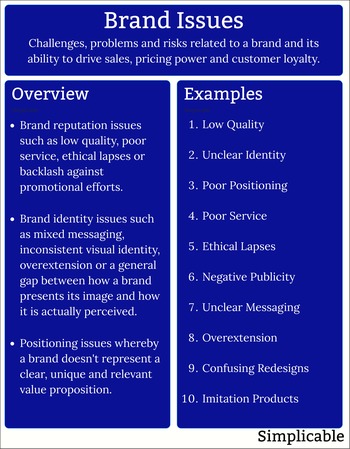
Adoption rates | Barriers to exit for customers |
Brand awareness | Brand identity & image |
Brand recognition | Build quality |
Cash position & debt | Competitive advantages |
Competitive disadvantages | Conformance quality |
Corporate culture | Corporate identity |
Customer acquisition cost | Customer behavior |
Customer churn | Customer complaints |
Customer experience | Customer loyalty |
Customer perceptions | Customer ratings & reviews |
Customer satisfaction | Customer segments |
Design quality | Distribution channels |
Employee satisfaction | Expansion plans |
Financial performance | Geographical coverage |
Goals | Gross margins |
Growth rate | Influencer relationships |
Innovation approach & budget | Intellectual property |
Major customers | Market niche |
Market share | Marketing budget |
Marketing campaigns | Online presence |
Operating margins | Overhead costs |
Partners | Press coverage |
Price strategy | Prices |
Product differentiation | Product lines |
Product positioning | Product reviews |
Product styles & colors | Promotion & advertising strategy |
Service culture | Social and environmental responsibility |
Strategy | Target customers |
Terms & conditions | Unit costs |
Visual identity | Why customers switch to your products |
Brand Awareness
The percentage of your target market that are familiar with the competitor's brand. Customers tend to buy what they recognize and it can be difficult to challenge a brand that is well known.Costs
Estimating the costs of a competitor's products from financial statements. In many industries, cost is a key factor and challenging a competitor that has efficiently scaled is difficult.Products
Identifying the strengths and weakness of the competitor's products from sources such as product reviews.Customer Experience
Evaluations of the competitor's customer experience such as customer service.Relationships
Considering the relationships of the competitor with regulators, partners, customers and communities.Distribution
Looking at the competitor's distribution strategy. For example, a competitor that doesn't compete in a particular region.Marketing
Considering the competitor's marketing strategies such as promotional activities and pricing.Risks
A summary of competitive strengths that are difficult to challenge.Opportunities
Opportunities such as dissatisfied customers, competitive disadvantages or niches that aren't served by competitors.| Overview: Competitor Analysis | ||
Type | ||
Definition | An assessment the position of potential competitors to identify the opportunities and risks of a strategy. | |
Related Concepts | ||

































